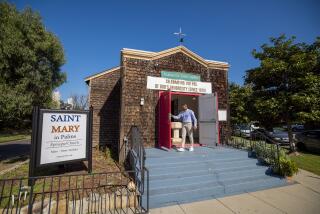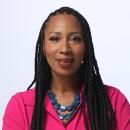New Rowland Heights mosque a product of grass-roots effort
The sand-colored mosque rises against the San Gabriel Mountains, its blue-tiled dome and six minarets cutting a striking profile in an industrial area of Rowland Heights.
Inside, lush tapestries from Pakistan adorn the walls, and ornate chandeliers from Dubai hang over the prayer rooms. At the head of the menâs prayer space, the 99 names of Allah are engraved in Islamic calligraphy into glass around the Arabic symbol for God.
After four years of construction and $5.5 million in fundraising, the Islamic Center of San Gabriel Valley formally opened its soaring new mosque Saturday. For Muslim worshipers, the transformation of their prayer space from a dilapidated church next to a smelly chicken farm purchased three decades ago to a 45,000-square-foot structure with a school, mortuary, health clinic and three libraries marks a coming of age for their community.
Itâs also powerful evidence of a building boom of new mosques in Southern California and around the nation.
Over the last several years, new mosques have risen in Mission Viejo, Irvine, Anaheim, Reseda, Rancho Cucamonga, Rosemead, Diamond Bar and Tustin. Additional mosques are slated for Temecula, Ontario, Lomita and Corona.
Strikingly, all of the new mosques have been funded entirely by local Muslims, who began settling in the region in the 1960s. Before 2001, new mosques were often funded by foreigners; the Saudis financed the King Fahad Mosque in Culver City, and Libyans helped build Masjid Omar near USC.
Stricter government scrutiny of foreign investments from Islamic countries after the Sept. 11 terrorist attacks, along with reluctance by local Muslims about accepting foreign money, helped change the practices, according to Shakeel Syed, executive director of the Islamic Shura Council of Southern California.
âPost 9/11, the dynamic completely changed,â Syed said. âThe Muslim community at large in North America realized it is better if we develop our own funding, however long it takes.â
Syed said many Muslims have built successful businesses over the last few decades and are now positioned to give back. Some did relatively well during the recession, as they were able to buy undervalued properties while not taking on risky investments or interest-incurring debt, which is barred in Islam, he said.
The majority of mosques in the United States are still existing buildings converted to an Islamic prayer space. But the number of newly built structures â such as the new Islamic Center of San Gabriel Valley â has doubled in the last decade, to 632 in 2011 from 314 in 2000, according to the American Mosque 2011 study. Among metropolitan areas, Southern California is home to 120 mosques, second only to the New York area, the study found. (Estimates of the Muslim American population vary, but a 2011 Pew Research Center study placed it at about 2.7 million nationwide and growing.)
At the new Masjid Qubaa in Rowland Heights, several members donated $100,000, and a few gave $500,000. The women held a fashion show, which raised $100,000. Dozens of skilled craftsmen contributed services and construction materials, which significantly reduced the structureâs cost.
Syed Rizvi, the centerâs president, reflects the arc of success experienced by some of the communityâs more affluent members. He arrived in the United States from Pakistan in 1975 with a single suitcase and $7,500. But he had a medical degree and eventually opened several kidney dialysis centers. He donated a six-figure sum to the project, said Yasmeen Khan, a mosque leader.
âWe were professionals, but we were not rich,â Rizvi said. âAmerica gave that opportunity for us all.â
A couple from Orange County gave the mosque an interest-free loan from their pension. And, Syed said, the Islamic Center of Corona gave the Rowland Heights group a bridge loan of a couple hundred thousand dollars â a common practice among Southern California mosques to share their resources.
The mosque construction attracted no local opposition â unlike projects in Temecula, Lomita and Ontario. There, neighbors raised concerns about potential problems with noise, traffic and parking â objections Muslims have successfully addressed, according to Ameena Mirza Qazi of the Council on American-Islamic Relations. Some of those debates were marked by anti-Islam comments and fears about terrorism expressed by some opponents.
Qazi said some Islamic centers have chosen to locate their new projects in industrial areas to avoid protests by homeowners. But doing so, she said, prevents mosques from serving as neighborhood centers, a traditional role for many religious institutions.
The San Gabriel Valley community, however, always located its Islamic center in an industrial area because the land was cheaper.
The original space, a church purchased in 1983, could fit only 300 people and was so cramped that worshipers during the monthlong Ramadan observance had to break their ritual fasts outside â even when the holiday fell during the chilly winter months. They bought a chicken farm to expand and rented space at Santa Ana High School, almost 25 miles away, to hold Sunday school. Preparations for burials were held at a mosque in Garden Grove.
By the late 1990s, members decided it was time to build a comprehensive facility. But the blueprint continued to change as the Muslim community grew.
Syed Raza, the architect, said the first plan drawn up nearly 15 years ago called for a 4,500-square-foot mosque â about one-tenth the size of the final design. The three-story structure includes separate entrances and prayer spaces for men and women, who can watch the imamâs sermon through closed-circuit TV on the second floor. Syed of the Shura Council said that most new mosques include separate prayer spaces for the comfort of both genders but that all intermingle in other areas of the center.
Worshipers are especially excited that the center will now finally house all of their needed facilities in one space, including the charter school and mortuary.
Non-Muslims are welcome to visit and use the services, mosque leaders said. Females will not be required to cover their heads as Muslims do, and young men can wear Bermuda shorts. Muslim leaders in Southern California say they are trying to be less insular and reach out more to the non-Muslim community by holding blood drives, food giveaways, interfaith meetings and other activities.
Last week, thousands of elated worshipers flocked to the gleaming new mosque for its inaugural Friday prayer meeting.
âIt feels like itâs a whole new world,â said 19-year-old Omar Yamak. âYou have a sense of love of the community.â
More to Read
Sign up for Essential California
The most important California stories and recommendations in your inbox every morning.
You may occasionally receive promotional content from the Los Angeles Times.












